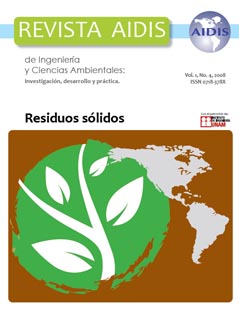Comparison between the use of different organic wastes in the reatment of hazardous wastes contaminated with Cr(VI)
Main Article Content
Abstract
This paper describes the results of the research on different treatment techniques for Cr(VI)-contaminated wastes, based on the stabilization by reduction to Cr(III).The reduction of Cr(VI) was performed by the application of organic wastes as reducing agents (tested in different mixture ratios) such as leachate from urban solid waste disposal sites, wastewater treatment plant sludge, whey, agave tequilana bagasse, citric wastes and green waste compost. The hazardous waste sample used in the research, was extracted from the abandoned site of the former plant “Cromatos de México”, was adjusted to the particle size and analyzed for physicochemical characteristics and Cr(VI) concentration. Test results showed that the reducing agents evaluated presented different capacities of reducing Cr(VI), with better results in mixture ratios of 1. Reduction efficiency varied from 84% for citric wastes to 7% for leachate. One of the advantages of using organic wastes as reducing agents is they are generally less toxic and can be cheaper than the inorganic reactives. The disadvantage is the reduction efficiency of the organic compounds is lower and their use may increase the waste mass, as in the specific case of citric wastes that increases the mass up to 35%. The work concluded that there are different alternatives of Cr(VI) reduction. However, due to the magnitude of the contamination (quantity and concentration) in Cromatos de México site, the application of one of these above mentioned technologies is not feasible in technical terms. The alternatives suggested are feasible only if applied to soils contaminated by Cr(VI) in concentrations below 12,000 ppm.
Article Details
How to Cite
[1]
De la Rosa Pérez, D.A., Velasco Trejo, J.A., Ramírez Islas, M.E. and Schmidt, W. 2009. Comparison between the use of different organic wastes in the reatment of hazardous wastes contaminated with Cr(VI). Revista AIDIS de ingeniería y ciencias ambientales: Investigación, desarrollo y práctica. 1, 4 (Nov. 2009).
